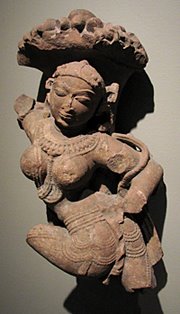
We identified it as a juvenile sharp-shinned hawk. Sibley describes it as “Our smallest accipiter; relatively small-headed, small-billed, and broad-winged.” It also states the sharp-shinned hawk, along with the other accipiters (Cooper’s Hawk and Northern Goshawk) are agile in pursuing small birds through trees and bushes. We decided on the identification both because of the bird’s relatively small size, and the broad, coarse brown streaks on its breast. Juvenile Cooper's and Goshawks have darker, thinner streaks, and are much larger.
 The starling tried to fly sideways when the hawk snagged it, but was forced down to the ground about eight feet from the feeding station. The hawk spread its wings, both I think to maintain its balance as the starling was frantically flopping about and also to corral its prey and prevent it from escaping in case it lost its grip on the bird (which didn't happen). This isn’t a great shot, but is the only one I got showing the hawk with its wings spread out.
The starling tried to fly sideways when the hawk snagged it, but was forced down to the ground about eight feet from the feeding station. The hawk spread its wings, both I think to maintain its balance as the starling was frantically flopping about and also to corral its prey and prevent it from escaping in case it lost its grip on the bird (which didn't happen). This isn’t a great shot, but is the only one I got showing the hawk with its wings spread out.It was using its talons to puncture the starling’s chest and almost immediately started ripping feathers out of the bird’s tail. Neither Elly nor I are starling fans, being well aware of the devastating effect they have had on native songbird species since being introduced to North America from Europe. Still, it was upsetting to watch the bird struggle as the hawk ripped out feathers. Within a few minutes, however, it started ripping at the starling’s neck, pulling its head off, which put an end to the struggling.

 At first, it tried to fly off with the starling, even before it had subdued the bird, but after one experimental takeoff attempt it gave up on that and went to work dispatching its prey, pulling out feathers, removing the head, and pulling off both wings. We thought it intended to eat the starling where it landed, but eventually realized it was removing all the extremities so the carcass would be easier to carry off. I was able to take over 160 digital images. Unfortunately, due to the angle from our kitchen door, one of the columns on our back porch was close to our line of sight and interfered with picture taking. Any attempt to go outside would have frightened the hawk away, so we kept watch from the kitchen.
At first, it tried to fly off with the starling, even before it had subdued the bird, but after one experimental takeoff attempt it gave up on that and went to work dispatching its prey, pulling out feathers, removing the head, and pulling off both wings. We thought it intended to eat the starling where it landed, but eventually realized it was removing all the extremities so the carcass would be easier to carry off. I was able to take over 160 digital images. Unfortunately, due to the angle from our kitchen door, one of the columns on our back porch was close to our line of sight and interfered with picture taking. Any attempt to go outside would have frightened the hawk away, so we kept watch from the kitchen.
Amazingly, this squirrel showed no fear of the hawk and seemed more curious about what it had than anything else. Squirrels have a tendency to rush birds feeding on the ground to flush them into the air and claim peanuts and the like for themselves. The squirrel didn’t try this with the hawk, but did come within a few feet of the bird’s watchful glare.

After about 45 minutes of pulling and tearing it finally carved the carcass down to a manageable bundle and flew off.

The aftermath was a two foot circle of feathers and small bits.

Mute testimony to the violent and cruel struggle in our backyard on a seemingly peaceful Saturday morning. The other birds soon returned and continued foraging.






No comments:
Post a Comment